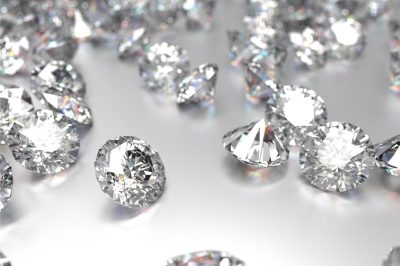There are many reasons not to buy a real diamond. It could be the high prices, the ethical concerns or the environmental impact from diamond mining. But what if you prefer and want the look of a diamond? Luckily, there are a number of diamond alternatives available on the market.
It might also be useful to note that stones or material that look similar to diamonds are sometimes called diamond simulants. Diamond simulants look like diamonds but have different chemical and physical properties.
Here are the best precious stones that look like a real diamond.
Moissanite
Our favorite gemstone on this list! Most people and even some jewelers are not able to tell the difference between moissanites and real diamonds. That is how closely moissanites look like real diamonds when it comes to appearances.
Not only that, moissanites are also one of the hardest gemstones next to diamonds. It is 9.25 on the Mohs scale while a real diamond is 10,
Moissanite has more brilliance and fire than a diamond. This means it has a more colorful light or sparkle. Some people feel that the fire of the moissanite makes it more beautiful than an actual diamond.
While moissanite was originally discovered in a meteorite, it is now lab-grown or synthetically produced. This makes moissanite an affordable as well as an environmentally friendly choice.
Price. Can cost around $300 to $600 for one carat.

Cubic Zirconia (CZ)
Cubic Zirconia is one of the most common and inexpensive diamond simulants. It’s a lab-created material that visually looks like a diamond but is less hard. Cubic Zirconia has a hardness of 8.5 on the Mohs scale, making it less durable. A real diamond is also heavier than cubic zirconia.
Similar to the moissanite, cubic zirconia also has a higher dispersion than diamonds. This means that when light reflects off it, cubic zirconia has a more colorful sparkle, a sort of rainbow-ish effect. On the other hand, a real diamond has a bright white sparkle.
Price. A cubic zirconia also stone can cost as little as a few dollars but can go up to around $100 for larger, high-quality stones. Note that low-quality cubic zirconia stones are more likely to be easily scratched and cloudy over time.
White Sapphire
White sapphires are natural gemstones that are colorless and can resemble diamonds. However, they are less hard (9 on the Mohs scale), less brilliant, and have less fire than diamonds. The sparkle of a white sapphire is a gray/silverish white compared to the brighter white of the diamond. White sapphire stones are often used as diamond substitutes in vintage and antique jewelry.
Price. The cost of white sapphires can vary. You might expect to pay anywhere from $200 to $600 per carat for a white sapphire.
White Topaz
White topaz is another natural gemstone that can be used as a diamond simulant due to its clear and colorless appearance. However, it is less hard (8 on the Mohs scale) and durable. This means that a diamond is significantly harder and more scratch-resistant than white topaz. White topaz is softer and more prone to scratching or damage, which may affect its long-term durability, particularly for everyday wear.
Additionally, white topaz is also less brilliant and sparkle less than diamond. It will also become cloudy and lose its sparkle over time.
Price. White topaz is an inexpensive gemstone. Prices can range from around $20 to $100 per carat depending on the quality of the stone.

Lab-Grown Diamonds
Lab-grown diamonds are different from the rest of the gemstones mentioned in this article as they are actually diamonds and are not diamond simulants.
Also known as synthetic or man-made diamonds, the lab-grown version have the exact same chemical and physical properties as natural diamonds. In every sense of the word, lab-grown diamonds are real diamonds.
It is worth noting that trained gemologists can use specialized equipment to tell the difference between lab-grown and natural diamonds based on certain microscopic features. But to the unaided eye, both types of diamonds look virtually identical.
Lab-grown diamonds also don’t have the same resale value as natural diamonds. This is due in part to perceptions of rarity and desirability in the gem market.
Price. However, one big difference between lab-grown diamonds and natural diamonds is the price. Lab-grown diamonds are less expensive than natural diamonds of comparable size and quality, often by as much as 30% to 50%. So if you want a real diamond without the cost, ethical and environmental concerns, then consider getting a lab-grown diamond.
If you are also considering alternative gemstones for your rings or jewelry that do not look like diamonds, then our article on non-diamond engagement rings might interest you!








